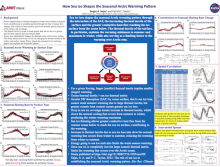How Sea Ice Shapes the Seasonal Arctic Warming Pattern
Sergio
Sejas
NASA Langley/ADNET Systems Inc.
Poster
In response to a positive CO2 forcing, the seasonal Arctic warming pattern is characterized by an early winter maximum and a summer minimum. Our analysis explores the relationship between the seasonal cycle of surface heating rate changes and the seasonal structure of Arctic warming. By decomposing the contributions to the background seasonal heating rate change, we find that reductions in sea ice cover and thickness are primarily responsible for the changes. Consistent across all models, we find that the background summer-to-winter surface cooling rate and winter-to-summer surface heating rate slows over sea ice regions in response to increased CO2. The winter warming peak results from sea ice melt, which transitions the Arctic surface from a lower thermal inertia surface (sea ice) to a higher thermal inertia surface (ice-free ocean) that slows the seasonal cooling that typically occurs from summer to winter. The seasonal cooling rate in autumn is further slowed by the thinning of sea ice, which allows for a greater conductance of heat from the ocean through the sea ice to the surface.

sejas-sergio-polar-poster.pdf
(6.61 MB)
